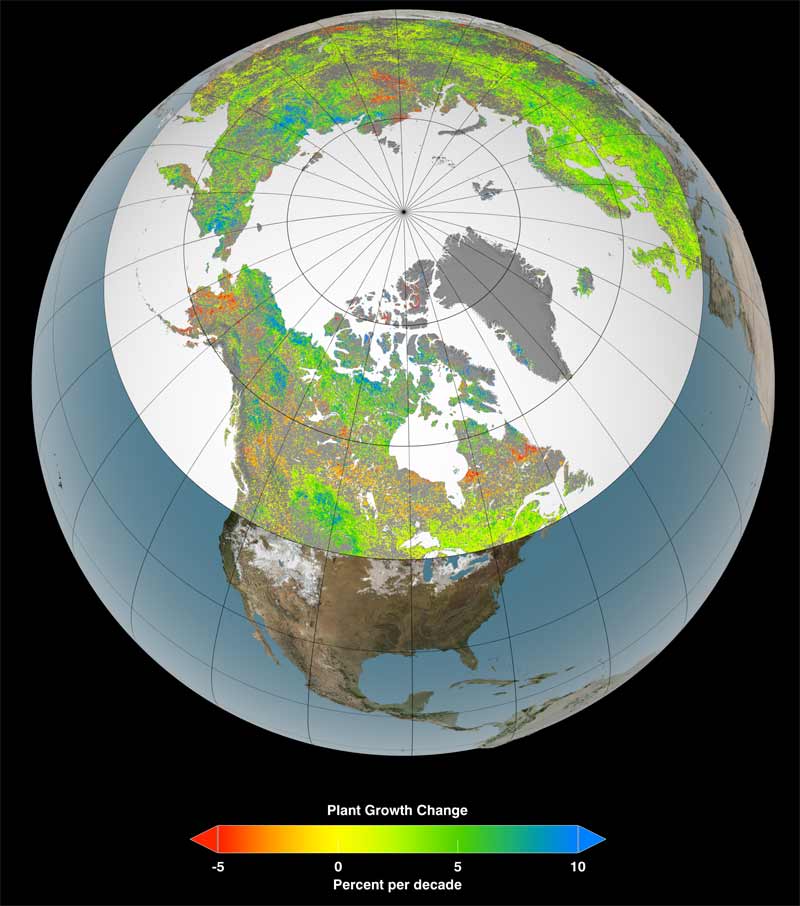Arctic Gets Greener As Climate Warms: NASA Study

Higher temperatures and a longer growing season mean some of Earth's chilliest regions are looking increasingly green, researchers say.
Today, the plant life at northern latitudes often looks like the vegetation researchers would have observed up to 430 miles (700 kilometers) farther south in 1982, according to a new study.
"It's like Winnipeg, Manitoba, moving to Minneapolis-Saint Paul in only 30 years," study researcher Compton Tucker of NASA's Goddard Space Flight Center in Greenbelt, Md., said in a statement.
Tucker and a team of university and NASA scientists looked at 30 years' worth of satellite and land surface data on vegetation growth from 45 degrees north latitude to the Arctic Ocean. In this region, large patches of lush vegetation now stretch over an area about the size of the continental United States and resemble what was found 4 to 6 latitude degrees to the south in 1982, the researchers say.
"Higher northern latitudes are getting warmer, Arctic sea ice and the duration of snow cover are diminishing, the growing season is getting longer and plants are growing more," climate scientist Ranga Myneni of Boston University said in a statement, adding that the changes are leading to great disruptions for the region's ecosystems. [10 Facts About Arctic Sea Ice]
The Arctic has been warming at a faster rate than the rest of the world in the past several decades, and Myneni says an amplified greenhouse effect is largely to blame for the changes in plant life. In this cycle, high concentrations of heat-trapping gasses drive up temperatures in the ocean and atmosphere. This warming cuts down Arctic sea ice and snow cover, causing the oceans and land surfaces in the region to be exposed (ice and snow are more reflective than darker surfaces); these surfaces absorb more heat from the sun's rays, which leads to further heating of the air and further reduction of sea ice and snow. Myneni warns that the cycle could get worse.
"The greenhouse effect could be further amplified in the future as soils in the north thaw, releasing potentially significant amounts of carbon dioxide and methane," Myneni said.
Using climate models, the team found that Arctic and boreal regions could see the equivalent of a 20-degree latitude shift by the end of this century due to rising temperatures. But this doesn't necessarily mean more and more plants. The researchers say the amplified greenhouse effect could have other consequences, like more forest fires, pest infestations and droughts, which cut vegetation growth.
And the availability of water and sunlight determines where plants will thrive. "Satellite data identify areas in the boreal zone that are warmer and dryer and other areas that are warmer and wetter," Ramakrishna Nemani of NASA's Ames Research Center in Moffett Field, Calif., explained in a statement. "Only the warmer and wetter areas support more growth."
Get the Space.com Newsletter
Breaking space news, the latest updates on rocket launches, skywatching events and more!
The researchers also saw more plant growth in the boreal zone from 1982 to 1992 than from 1992 to 2011 — a trend they attributed to a lack of water in the region during the last two decades of the study.
The research was detailed Sunday (March 10) in the journal Nature Climate Change.
This story was provided by LiveScience, a sister site to SPACE.com. Follow LiveScience on Twitter @livescience. We're also on Facebook & Google+.
Join our Space Forums to keep talking space on the latest missions, night sky and more! And if you have a news tip, correction or comment, let us know at: community@space.com.
For the science geek in everyone, Live Science breaks down the stories behind the most interesting news and photos on the Internet, while also digging up fascinating discoveries that hit on a broad range of fields, from dinosaurs and archaeology to wacky physics and astronomy to health and human behavior. If you want to learn something interesting every day, Live Science is the place for you.












